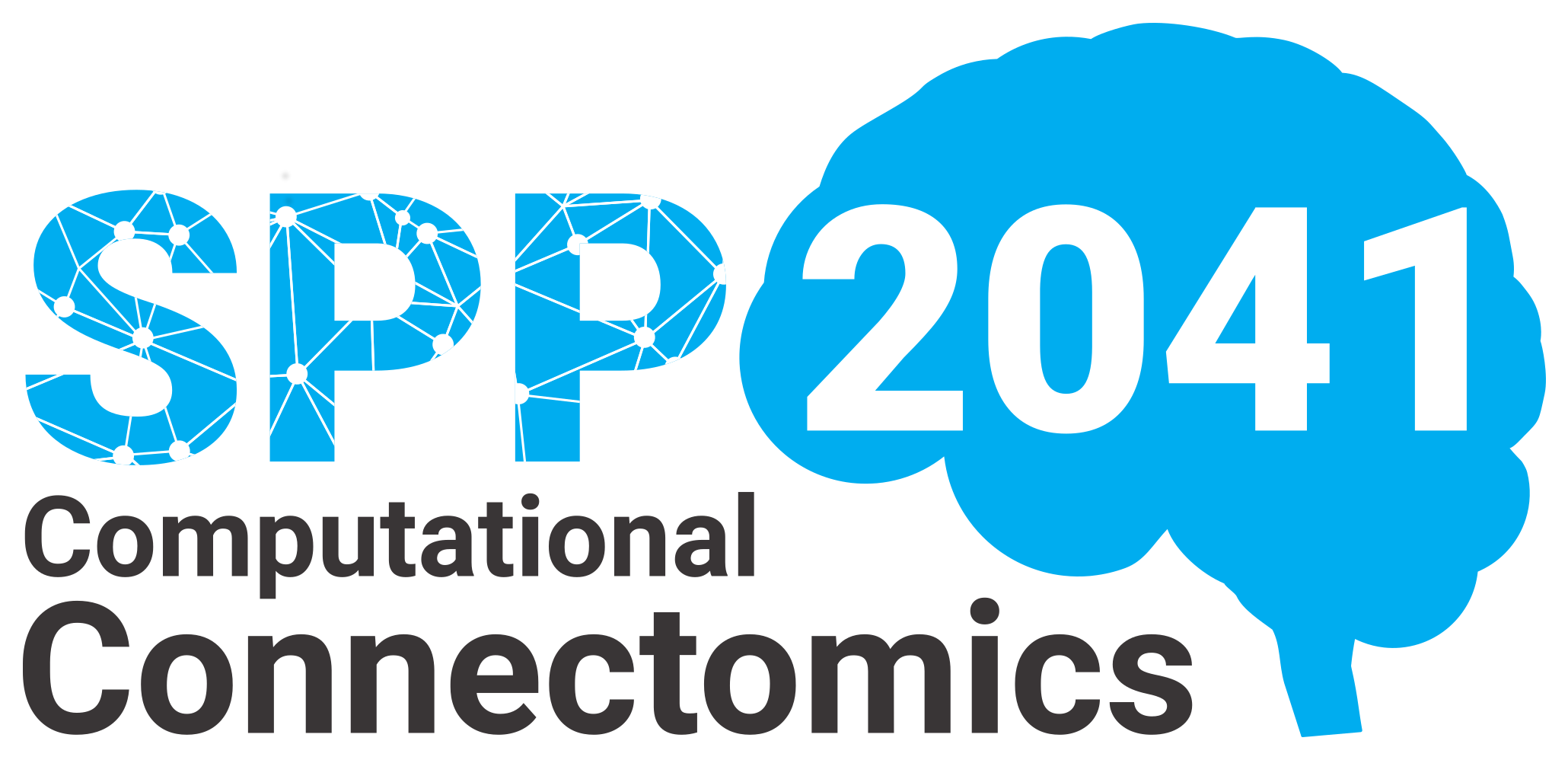The Dynamic Connectome
A workshop of SPP2041 Computational Connectomics
Date: October 15, 2020
Location: https://us02web.zoom.us/j/83945542743
Organizers: Jochen Triesch, Frankfurt Institute for Advanced Studies, Germany
Claus Hilgetag, University Medical Center Hamburg-Eppendorf, Germany
Schedule (all times refer to Central European Time (CET) zone)
1:30 pm – 1:40 pm Jochen Triesch & Claus Hilgetag: Opening Remarks
1:40 pm – 2:30 pm Noam Ziv, Technion, Israel (40+10): Synaptic tenacity or lack thereof:
Spontaneous remodeling of synaptic connections
2:30 pm – 3:00 pm Marcus Kaiser, Newcastle University, UK (20+10): Spatial and Topological
Connectome Features support Flexible Dynamics between Tasks
3:00 pm – 3:30 pm Ileana Hanganu-Opatz, University Medical Center Hamburg-Eppendorf,
Germany (20+10): Development of prefrontal hubs in health and disease
3:30 pm – 4:00 pm coffee break
4:00 pm – 4:30 pm Viola Priesemann, MPI for Dynamics and Self-Organization, Germany
(20+10): Small synaptic changes can strongly impact network dynamics
4:30 pm – 5:00 pm Simon Rumpel, JGU Mainz, Germany (20+10): Intrinsic and extrinsic
dynamics of the mouse auditory cortex
5:00 pm – 5:50 pm Jeff Lichtman, Harvard University, USA (50+10): Searching for connectivity principles in connectomic data
5:50 pm – 6:30 pm Open Discussion, Aperó
Overview
Recent years have witnessed rapid progress in the extraction and quantification of connectomes, the wiring diagrams of nervous systems, at both local circuit and whole brain scales. This research program is fuelled by the hope that reconstructing the brain's detailed wiring patterns will facilitate a deeper understanding of its function. However, connectomes are by no means static, but they dynamically change across a wide range of time scales. This raises important questions: What can we infer about the function of a dynamic network structure based on single snapshots? How can we best describe and understand the dynamics of connectomes? What are the mechanisms by which connectomes dynamically modify their wiring? What are the functional benefits of dynamic connectomes? This workshop will address these questions from experimental and computational perspectives.
Abstracts
Hanganu-Opatz, Ileana: Development of prefrontal hubs in health and disease
The functional architecture of the developing neocortex is still poorly understood. Combining new optogenetic and electrophysiological approaches, we recently elucidated the contribution of pyramidal neurons to the maturation of beta-gamma rhythms entraining prefrontal circuits in neonatal mice. Moreover, we showed that the excitation/inhibition balance tilts towards inhibition as development progresses but, already at 2-3 days of age, prefrontal interneurons display adult-like inhibitory properties. Using a variety of statistical methods to analyze >200.000 pairs of single unit spike trains, we show that correlations at all scales decrease throughout development, and that increasing inhibition is instrumental in this process. These data give first insight into the developmental mechanism of pyramidal and interneuronal wiring within prefrontal circuits.
Kaiser, Marcus: Spatial and Topological Connectome Features support Flexible Dynamics between Tasks
The anatomical organization of the brain is shaped by competing constraints for improving brain function while reducing the costs for connectome wiring. Concerning this trade-off the human brain, as previously found for non-human primates, shows a non-optimal placement of brain regions where alternative arrangements would reduce the total wiring. This nonoptimal organization is mainly due to long-distance connections between the frontal and occipital/parietal lobes that act as short-cuts. By using a model of brain activity, this arrangement of the connectome promotes fluctuations in synchronization between regions, such higher metastability is associated with flexible behavioral responses. Altogether, this highlights that the wiring of the connectome, whilst costly to build, may offer dynamic advantages that support cognition.
Lichtman, Jeff W.: Searching for connectivity principles in connectomic data
Connectomics provides otherwise inaccessible detailed synaptic circuitry of nervous systems – circuits that presumably underlie behavior. While this is potentially reason enough to do the painstaking task of imaging and rendering wiring diagrams from brains, I would like to argue that this approach also may provide principles of neural circuit organization as a means to understand circuit properties, like experience-based circuits, that will be different in every instance. I will describe 4 rather short vignettes from a diverse set of studies I have participated in. It is my hope that these little tales speak to a common principle, but that is up for debate.
Priesemann, Viola: Small synaptic changes can strongly impact network dynamics
Assuming we know the connectome of a species or a network, can we predict its dynamics without precise knowledge of the synaptic weights? – We show for generic networks that their dynamics can strongly change even when the excitatory synaptic strength only changes by a few percent. Such a strong sensitivity to the precise synaptic strength occurs close to phase transitions and critical states. We provide experimental evidence that such sensitivity may be employed – to very different degrees – by cortical networks. Thereby we highlight a feature that enables fine-tuning of a network to task requirements in a very flexible manner.
Rumpel, Simon: Intrinsic and extrinsic dynamics of the mouse auditory cortex
The primary role of sensory cortex has been traditionally considered to process information from the periphery to form basic representations that are read out by higher-order centers of the brain to guide behavior. This view emphasizes a fixed input-output relationship, in which the major determinant of the activity patterns that can be observed in sensory cortex is the sensory input. However, with the advent of technologies allowing chronic measurements of neural structure and function, the emerging picture is that neural networks undergo significant remodeling over multiple timescales, even in the absence of experimenter-induced learning or sensory perturbation – or even neuronal activity. Using the mouse auditory cortex as a model for longitudinal imaging studies in vivo, I will present data on the long-term dynamics of synaptic connections and auditory representations and discuss how intrinsic, sensory-independent dynamics impact on the processing of auditory stimuli.
Ziv, Noam: Synaptic tenacity or lack thereof: Spontaneous remodeling of synaptic connections
Activity-dependent modifications to synaptic connections – Synaptic Plasticity – is widely believed to represent a fundamental mechanism for altering network function. This belief also implies, however, that synapses, when not driven to change their properties by physiologically relevant stimuli, should retain these properties over time. Otherwise, physiologically relevant modifications would be gradually lost amidst spurious changes and spontaneous drift. We refer to the expected tendency of synapses to hold on to their properties as Synaptic Tenacity.
Imaging studies reveal that synapses are not truly structures and are better thought of as dynamic assemblies of molecules that move in, out and between synaptic sites. These innate dynamics, combined with continual turnover of synaptic molecules and the challenging logistics of providing remote synapses with essential molecules at appropriate amounts and stoichiometries, question the biological plausibility of perfectly tenacious synapses. Indeed, we find that synaptic properties do change spontaneously in manners that do not depend on particular activity histories, or for that matter, on activity at all. In fact, we find that less than half of the changes we observe can be attributed to particular activity histories. Interestingly, however, we find that spontaneous changes to synaptic properties are governed by well characterized stochastic processes, which seem to be driven by the innate dynamics of synaptic molecules. These dynamics, and the spontaneous synaptic changes they generate, both shape and confine synaptic size distributions, continuously renormalize synaptic sizes but at the same time, continuously erode synaptic size configurations.
Our findings thus indicate that synaptic tenacity is inherently limited. Moreover, they suggest that synaptic properties – both at individual synapse and population levels – are governed by processes that have substantial stochastic components.

